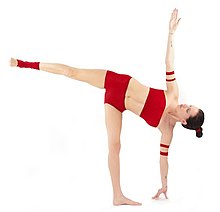Ardha chandrasana

Ardha Chandrasana (Sanskrit: अर्धचन्द्रासन; IAST: Ardha Chandrāsana) or Half Moon Pose[1] is an asana.[2]
Etymology
The name comes from the Sanskrit words Ardha meaning "half", Candra or Chandra (चन्द्र) meaning "moon" or "luminous, as in the light from the moon", and Asana (asana, Āsana) meaning "posture" or "seat".[3]
Benefits
Like all standing balance asanas, ardha chandrasana offers many benefits related to focus and proprioception, and strengthening of hip and knee muscles. This asana is particularly beneficial to the external rotators and stabilizers of the hip including gluteus medius and minimus, obturators (external and internal) and gemelli (inferior and superior). Abduction of the hip is achieved through concentric contraction of tensor fascia latae, gluteus medius and minimus on both legs (lifting one and stabilizing the other). Both legs engage articularis genu, hip flexors and quadriceps to maintain leg extension,to relax,help in improvement in sports, while the supporting leg stretches the gastrocnemius, hamstrings and gluteus maximus. Upper body stability is achieved by a number of paraspinal and core muscles like the abdominals and obliques (external and internal), while the chest is opened by the rhomboids, and trapezius and the arms are abducted by the deltoids, externally rotated by the infraspinatus and stabilized by the latissimus dorsi.[4]
Variations
- Parivrtta Ardha Chandrasana (Revolved Half Moon Pose),[5] parivrtta (परिवृत्त) meaning "revolved" or "twisted"
In Sivananda Yoga and its derivative styles such as the Bihar school, half moon pose refers to anjaneyasana, an asana used in the moon salutation series (Chandra Namaskar). In Bikram Yoga, half moon pose refers to a two-legged standing asana known as Indudalasana.
See also
References
- ^ "Ardha Chandrasana". Retrieved 2011-04-09.
- ^ McGilvery, Carole; Mehta, Mira (2002). The encyclopedia of aromatherapy, massage and yoga. Hermes House. p. 247. ISBN 978-1-84309-129-5. Retrieved 9 April 2011.
- ^ Sinha, S.C. (1 June 1996). Dictionary of Philosophy. Anmol Publications PVT. LTD. p. 18. ISBN 978-81-7041-293-9. Retrieved 9 April 2011.
- ^ http://www.gaiamtv.com/article/interconnections-ardha-chandrasana-half-moon-pose
- ^ "Parivrtta Ardha Chandrasana (Revolved Half Moon Pose)". Retrieved 2011-04-09.
Further reading
- Iyengar, B. K. S. (1 October 2005). Illustrated Light On Yoga. HarperCollins. ISBN 978-81-7223-606-9. Retrieved 9 April 2011.
- Saraswati, Swami Satyananda (1 August 2003). Asana Pranayama Mudra Bandha. Nesma Books India. ISBN 978-81-86336-14-4. Retrieved 9 April 2011.
- Saraswati, Swami Satyananda (January 2004). A Systematic Course in the Ancient Tantric Techniques of Yoga and Kriya. Nesma Books India. ISBN 978-81-85787-08-4. Retrieved 9 April 2011.
External links

